Is a bicycle a vehicle and what type does it belong to?
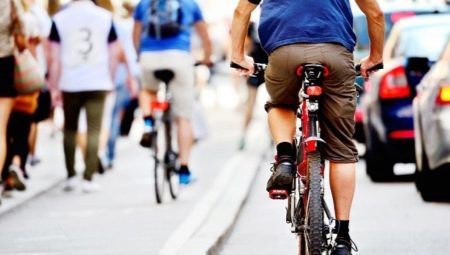
When we talk about transport, we represent the image of a car, trolleybus, bus or some other vehicle, but we usually don't take a bicycle seriously. Quite often on the roads you can see cyclists hugging the curbs for their safety. The article will discuss whether a bicycle is considered a means of transport, and if so, what type it belongs to.


Vehicle definition
According to the definition from the traffic rules, transport includes devices for transporting people, as well as cargo and equipment installed in transport. This is stated in paragraph 1.2 of the code of the road. That is, the main function of a vehicle is transportation. The classification implies several types:
- rail;
- wheeled;
- crawler.
According to the rules of the road, a bicycle is also a wheeled mechanical type of vehicle, set in motion by the force of the muscles of a person sitting on it, or by means of an electric motor, which has a maximum power during prolonged movement of no more than 0.25 kW and turns off at a speed of more than 25 km. / h

A cyclist is considered a bicycle rider, he is obliged to comply with the rules of the road and be responsible for their non-observance and for traffic safety. This is especially true for those cyclists who ride on the highway.
Having entered the carriageway, the cyclist becomes a full participant in the road traffic just like the driver of cars or public transport. However, not all bicycle riders are conscious people, despite the fact that they are already quite adults. Only persons over the age of 14 are allowed to use the motorway. Very often, cyclists and older ones behave on the road like pedestrians.
It should always be remembered that when dismounting from a bicycle, a person obeys the general rules for pedestrians, and while riding a bicycle - the rules for car drivers.
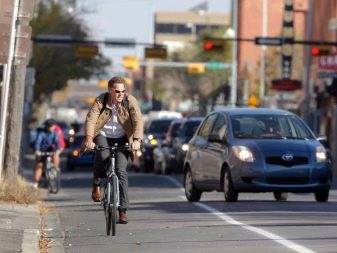
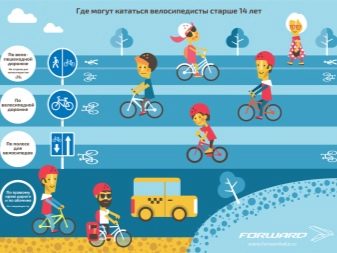
Obligations of the cyclist
The cyclist is obliged to equip his bike with headlights. The front is attached white, the back is red, like a car. Equip the wheels at the rear, front and sides with reflectors so that in the dark other drivers understand who is driving in front. Also, the bike must have a handlebar, braking system and sound signal in perfect condition. To carry passengers, there must be a special seat attached to the trunk or frame... This applies to the transportation of preschool children.
A cyclist is obliged to move along the motorway along the extreme right lane if a cycle path is not provided for on this section. If it is, then it is allowed to move only along it. On the highway, the cyclist moves in the same direction as other vehicles, and not in the opposite direction.
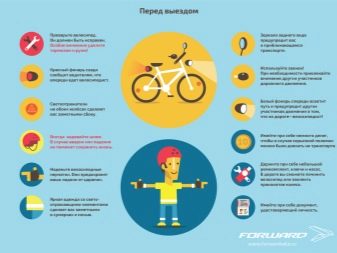
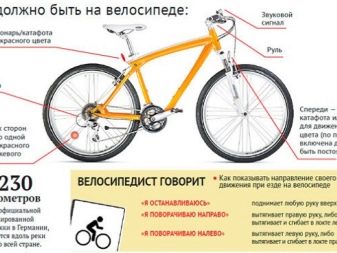
Bicycle columns must move in one row, the maximum number is 10 people. If the group of athletes is larger, it is necessary to divide into 2, 3 or more columns depending on the number of cyclists. The distance between the columns must be at least 80 meters for sufficient space for vehicles to maneuver.
The bike has no turn signals, but nonetheless the person driving this transport is obliged to give signals indicating his intentions. If he wants to make a turn to the left, it means that he shows it with the help of his left hand extended in that direction, if to the right, then his right. When the cyclist wants to stop, he should extend one arm high up.
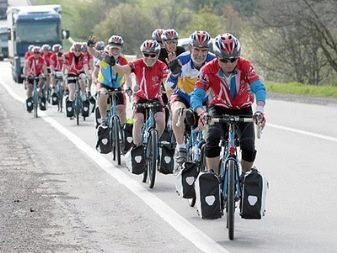
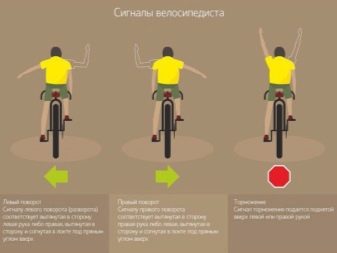
Cyclists are allowed to move on the sidewalks only if a preschool passenger or those accompanying the convoy of schoolchildren are being transported. If a cyclist interferes with the movement of pedestrians, then he must continue his journey, dismounted to the ground like a pedestrian. He will be able to sit behind the wheel of a bicycle again on freer sections of the path.
Must move following the directions of the road signs, specially provided for cyclists, as well as follow the requirements of road signs that are provided for any road user. On unregulated pedestrian crossings, the cyclist lets pedestrians pass in the same way as if he was driving a car.
To cross an intersection, a cyclist must make a reference point at a special signal of a "bicycle" traffic light. If there is none, then there is a reference point for the general.

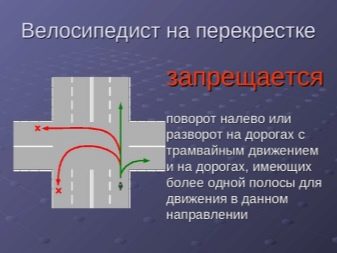
Prohibitions and offenses
Along with the obligations, there are also prohibitions that are provided for in paragraph 24.8 of the SDA. It lists what is strictly prohibited for a cyclist.
- Let go of the handlebars when driving anywhere. This applies to motorways, sidewalks and special bike paths.
- Transportation of cargo that does not correspond in size to the permissible standards. The load should not protrude more than half a meter to either side.
- Carriage of passengers on a bicycle that does not have special equipment.
- Cycling along the pedestrian crossing. You must dismount.
- Move without a special helmet or with the locks unbuttoned.
- Make a U-turn or turn to the left on tram lines and on a road where several lanes are indicated.
- It is prohibited to tow anything other than trailers.
- Sit behind the wheel in a state of alcoholic or drug intoxication.
- Drive after taking intoxicating or strong medicines.
- Use the motorway if there is a cycle path nearby.
- Drive along the side of the road or along the median strip.
- Transfer the driving of a bicycle to another person who has ridden a long distance without rest, who is drunk, under narcotic intoxication or who takes strong medications.
- Communicate on the phone without a headset while driving.
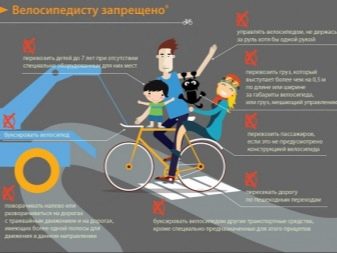

Traffic fines
Since the person driving the bicycle is the driver of the vehicle, especially if he rides on the road, then fines and penalties are imposed if the rules and laws are violated. The Code of Administrative Offenses of the Russian Federation (Code of Administrative Offenses) says what exactly the fine is charged for.
So:
- any offense by a cyclist is fined 800 rubles;
- if the rule is violated in a state of drug or alcohol intoxication, then the fine is already from 900 to 1600 rubles;
- when interfering with the movement of vehicles, a fine is charged in the amount of 800 rubles;
- in case of harm to human health - a fine from 900 to 2000 rubles, depending on the severity of the damage.
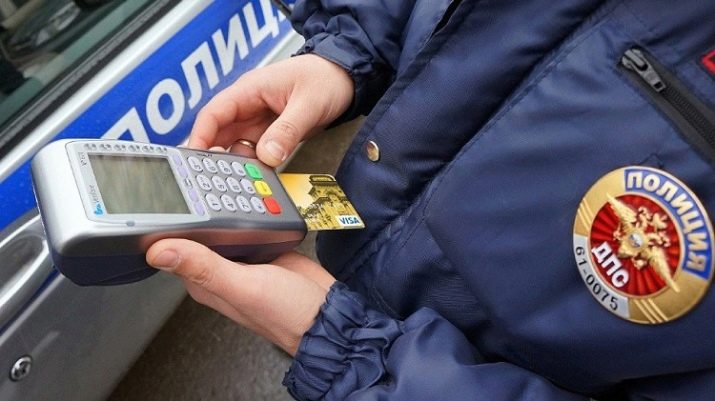
Road signs for the bike driver
There are three main bicycle signs, of which two are prescriptive and one prohibiting:
- "Crossing a cycle path with a pedestrian" and others is a prescriptive sign;
- the sign "bike path" is also prescriptive;
- the sign "cycling is prohibited" - prohibiting.
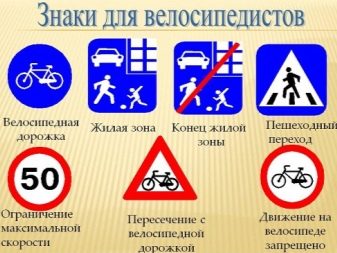
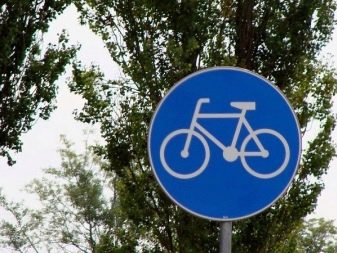
There are also general signs that a cyclist needs to take into account, such as:
- "Movement Prohibition";
- "road up";
- “Road only for cars”;
- "Pedestrian zone" or "footpath".
Taking into account all the rules and regulations for cyclists, you can enjoy the ride, combining business with pleasure.
Cycling is not only a sustainable way of getting around, but also physical training.


In the next video you will find road rules for cyclists.








